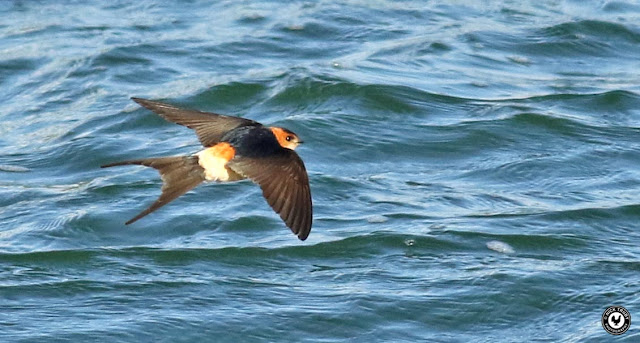It wasn't a particularly nice morning weather wise with a fairly strong breeze and clouds threatening but at least there were a few brief sunny spells to warm us, and the birds, up a bit. Not that the Nightingales were bothered, we could hear one singing immediately on exiting the car. The said singer was reciting its rich and varied song from within a Hawthorn bush just 20 yards away and as soon as we were ready we stationed ourselves close to the bush. This wouldn't be easy though since the Hawthorn was heavy with blossom and all of its leaves were unfurled. After over half an hour of intense scrutiny of the bush, during which time the bird sang almost continuously, I finally found the it! Well I could see a bit of it anyway......
 |
| Nightingale! |
The Nightingale returned to its favourite Hawthorn tree and sang once again from deep cover so we decided to walk out onto the common initially in the hope of finding a Dartford Warbler or Woodlark. We could hear another couple of Nightingales singing from other areas of the common and earmarked looking for one of them on our return. The weather, as is often typical for a Bank Holiday, had closed in somewhat and now threatened rain. This was to my favour though since a flock of Swifts appeared, however much to Mrs Caley's disdain since me trying to photograph Swifts is a constant source of annoyance to her!
 |
| Swift |
Completely forgetting about the other previously mentioned targets, we stayed with the Nightingale and tracked it around its territory. This enabled us to pick a spot to sit and wait and after a short wait we were treated to some more views at it sang from within the tangle of a Gorse bush.
It then jumped to a slightly more open bush where it sang much more enthusiastically allowing us even better views. This particular Nightingale after starting out very elusive had now turned out to be a very seeable bird indeed.
We checked in one of the other Nightingales on our walk back to the car but that one was very tricky to see, our views limited to typically obscured ones only. Taking a bit of time to locate a singing Nightingale, along with finding similarly reeling Grasshopper Warblers, is great sport though and a challenge that I never tire of.
Without wishing my life away I look forward to the Nightingales returning again next Spring already so that I can play the game once more!



























































